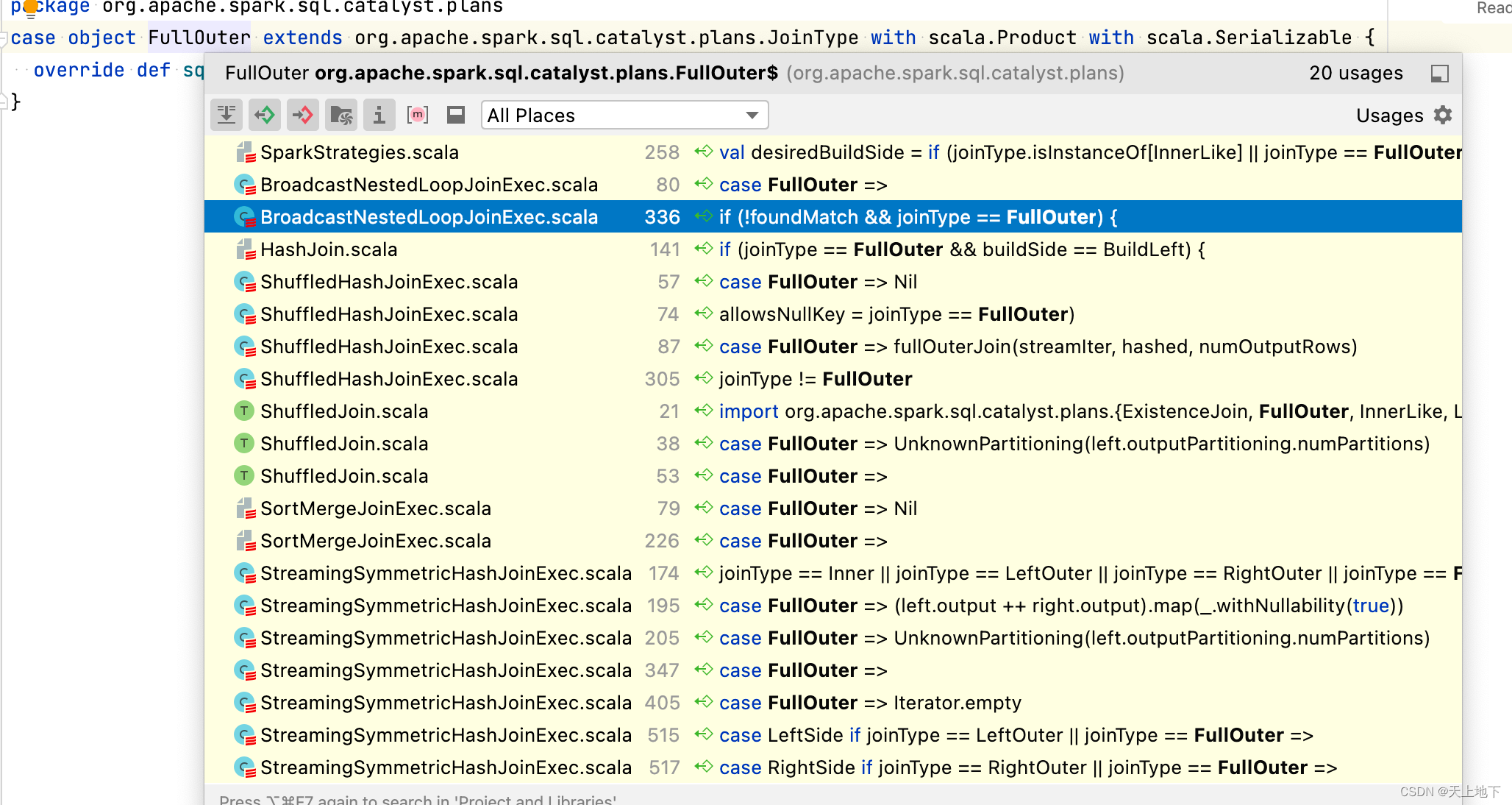变迁历史
Spark3.1.0版本之前,shuffle hash join(SHJ)支持除了full outer join之外的类型,此时对于一个full outer join的等值join的sql,会使用smj,smj缺点就是在表很大的时候会增加排序所需的cpu和io,而SHJ可以排序所需的CPU和IO,特别是表比较大的时候。
而从3.1.0版本开始, Shuffle-Hash Join (SHJ) 支持所有的 join 类型(SPARK-32399),同时支持相应的 codegen execution(SPARK-32421)。
3.1.0版本怎么支持Full Outer Join
具体处理方式:
- 通过哈希关系查找处理流侧的行,并通过以下方式标记构建侧( build side)的匹配行:
- 对于具有唯一键的连接,使用 BitSet 记录构建侧的匹配行(key index表示每一行)。
- 对于具有非唯一键的连接,使用 HashSet[Long] 记录构建侧的匹配行(key index+value index表示每一行)。
key index定义为BytesToBytesMap中longArray的index key
(is defined as the index into key addressing array longArray in BytesToBytesMap.)
value index 定义为相同键的值的 iterator index 。
- 通过迭代哈希关系处理构建侧的行,并过滤已经查找过的构建侧行(在 ShuffledHashJoinExec.fullOuterJoin 中完成)。
可以看到full outer shuffled hash join将迭代 两次 build side(一次用于构建hash map,另一次用于输出不匹配行)和迭代一次 stream side
而full outer sort merge join需要两边都迭代两次,并且对大表进行排序可能会更加消耗CPU和IO。因此,当 stream side比build side大得多时,full outer shuffled hash join比full outer sort merge join更有效。
相关源码
在org.apache.spark.sql.execution.joins.ShuffledHashJoinExec中:
private def fullOuterJoin(
streamIter: Iterator[InternalRow],
hashedRelation: HashedRelation,
numOutputRows: SQLMetric): Iterator[InternalRow] = {
val joinKeys = streamSideKeyGenerator()
val joinRow = new JoinedRow
val (joinRowWithStream, joinRowWithBuild) = {
buildSide match {
case BuildLeft => (joinRow.withRight _, joinRow.withLeft _)
case BuildRight => (joinRow.withLeft _, joinRow.withRight _)
}
}
val buildNullRow = new GenericInternalRow(buildOutput.length)
val streamNullRow = new GenericInternalRow(streamedOutput.length)
lazy val streamNullJoinRowWithBuild = {
buildSide match {
case BuildLeft =>
joinRow.withRight(streamNullRow)
joinRow.withLeft _
case BuildRight =>
joinRow.withLeft(streamNullRow)
joinRow.withRight _
}
}
val iter = if (hashedRelation.keyIsUnique) {
fullOuterJoinWithUniqueKey(streamIter, hashedRelation, joinKeys, joinRowWithStream,
joinRowWithBuild, streamNullJoinRowWithBuild, buildNullRow, streamNullRow)
} else {
fullOuterJoinWithNonUniqueKey(streamIter, hashedRelation, joinKeys, joinRowWithStream,
joinRowWithBuild, streamNullJoinRowWithBuild, buildNullRow, streamNullRow)
}
val resultProj = UnsafeProjection.create(output, output)
iter.map { r =>
numOutputRows += 1
resultProj(r)
}
}BHJ和SMJ在full outer join上的性能对比
例如下面的查询,与full outer sort merge join相比,full outer shuffled hash join节省了 30% 的wall clock time 。注意,当构建端(build side)很大时,SHJ 可能会导致 OOM,因为构建 hashmap 是内存密集型的。
"wall clock time"是指实际时间,也称为挂钟时间或墙上时间。这是指从一个事件的开始到结束所经过的实际时间,包括所有时间延迟和等待时间。
Wall clock time包括了计算机系统中的各种时间消耗,比如CPU执行时间、I/O操作等等。它可以用来评估一个程序或操作的整体执行时间,包括了所有可能的延迟和等待时间,反映了程序在实际环境中的整体执行效率。
与之相对的,CPU时间只计算CPU实际执行代码的时间,不包括等待I/O操作、线程切换等操作所消耗的时间。 Wall clock time更能真实地反映一个任务的总体耗时,因为它包含了所有可能的时间开销,而不仅仅是CPU的执行时间。
def shuffleHashJoin(): Unit = {
val N: Long = 4 << 22
withSQLConf(
SQLConf.SHUFFLE_PARTITIONS.key -> "2",
SQLConf.AUTO_BROADCASTJOIN_THRESHOLD.key -> "20000000") {
codegenBenchmark("shuffle hash join", N) {
val df1 = spark.range(N).selectExpr(s"cast(id as string) as k1")
val df2 = spark.range(N / 10).selectExpr(s"cast(id * 10 as string) as k2")
val df = df1.join(df2, col("k1") === col("k2"), "full_outer")
df.noop()
}
}
}
Running benchmark: shuffle hash join
Running case: shuffle hash join off
Stopped after 2 iterations, 16602 ms
Running case: shuffle hash join on
Stopped after 5 iterations, 31911 ms
Java HotSpot(TM) 64-Bit Server VM 1.8.0_181-b13 on Mac OS X 10.15.4
Intel(R) Core(TM) i9-9980HK CPU @ 2.40GHz
shuffle hash join: Best Time(ms) Avg Time(ms) Stdev(ms) Rate(M/s) Per Row(ns) Relative
------------------------------------------------------------------------------------------------------------------------
shuffle hash join off 7900 8301 567 2.1 470.9 1.0X
shuffle hash join on 6250 6382 95 2.7 372.5 1.3X3.1.0版本之前为什么不支持full outer join
3.1.0之前的版本中,之所以SHJ不支持full outer join,主要是因为在执行shuffle hash join时,Spark会将两个输入数据集按照指定的连接键进行分区,然后在每个分区节点上的数据单独执行单机hash join算法。
在执行join操作时,Spark会将相同连接键的数据进行合并。如果使用hash join来实现全连接,那么可能会导致一些连接键只出现在一个数据集中而没有出现在另一个数据集中,这样就无法准确地将两个数据集进行合并。
例如,本来是table_a={id:1,id:2,id:3,id:4},table_b={id:1,id:2,id:3,id:4},则table_a和table_b中id=1/id=4的数据发到节点1,id=2的数据发到节点2,id=3的数据发到节点3,那样在各自节点上进行table_a full outer join table_b on table_a.id=table_b.id就会分别得到:
节点1:{1,1},{4,4} -- 缺少了{id=2, null}{id=3, null},因为根本该节点上根本不知道有id=2,3
节点2:{2,2} -- 缺少了{id=1, null}{id=3, null}{id=4, null},因为根本该节点上根本不知道有id=1,3,4
节点3:{3,3} -- 缺少了{id=1, null}{id=2, null}{id=4, null},因为根本该节点上根本不知道有id=1,2,4
Broadcast hash join支持full outer join吗?
目前还不支持。

从源码可以看到,支持full outer join的有BNLJ,SHJ,SMJ
Cartesian product join适合没有指定连接条件,支持等值和不等值 Join,只支持内连接(因为笛卡尔积没有啥实际意义,只有使用on语句形成内连接才有意义),下面代码就写死了inner
跟上面SHJ的例子一样,如果BHJ支持full outer join,则也会遇到以下情况,小表只能跟各个节点上拥有的个别id集合进行join,因而不能支持full outer join:
大表table_a={id:1,id:2,id:3,id:4},广播的小表table_b={id:1,id:4},则table_b中id=1/id=4的数据发到各个节点上,其中节点1中table_a的数据是{id:1,id:4},节点2中table_a的数据是{id:2},节点3中table_a的数据是{id:3},那样在各自节点上进行table_a full outer join table_b on table_a.id=table_b.id就会分别得到:
节点1:{1,1},{4,4} -- 缺少了{id=2, null}{id=3, null},因为根本该节点上根本不知道有id=2,3
节点2:{1,null},{2,null},{4,null} -- 缺少了{id=3, null},因为根本该节点上根本不知道有id=3
节点3:{1,null},{3,null},{4,null} -- 缺少了{id=2, null},因为根本该节点上根本不知道有id=2






















 1921
1921











 被折叠的 条评论
为什么被折叠?
被折叠的 条评论
为什么被折叠?








